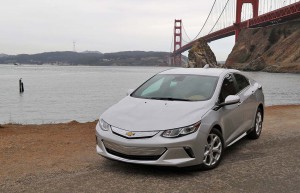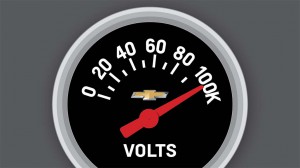Chevrolet is marking an important milestone, General Motors’ biggest brand taking an order for the 100,000th Volt plug-in hybrid-electric vehicle.
The Chevy Volt has been one of the world’s top-selling plug-based vehicles ever since its launch in December 2010, but tempering any celebration is the fact that the Volt hasn’t come close to meeting the brand’s once-ambitious sales targets. At one point, GM officials were hoping to deliver as many as 40,000 of the vehicles annually in the U.S. alone.
“Not only is the Volt a class-creator, it serves as the foundation of a Chevrolet electric family that will soon add the first long-range, affordable EV available to customers across the U.S., the Chevrolet Bolt EV,” said Steve Majoros, director of marketing, Chevrolet Cars and Crossovers, in a statement.
Few would argue with the fact that the original Chevy Volt was a game-changer. It was the first model from a major automaker to pair a plug-based electric motor and a gasoline engine under the hood. On battery power alone, what Chevy preferred calling an extended-range electric vehicle could go for more than 35 miles a charge and then switch to gas power for longer trips.
But after an early burst of demand, sales routinely fell below target, with Volt lagging behind the competitor it was most often compared with, the pure battery-electric Nissan Leaf. Worldwide, the Japanese BEV managed to clock 200,000 sales by the end of 2015.
But plug-based vehicles – indeed, battery vehicles in general, including conventional hybrids like the Toyota Prius – have been suffering over the last several years as gasoline prices have collapsed. Last year marked the first time since Leaf and Volt were introduced that sales of plug-based models declined.

The 2016 Chevy Volt improved its battery-only range from 38 miles to 53 miles. Plug-based car sales are expected to jump this year.
(Hyundai working on 250-mile EV. For more, Click Here.)
The numbers have been rebounding this year, however, in part due to new entries. And the Chevy Volt has finally regained the U.S. lead over the Nissan Leaf. Through June, Chevrolet sold 9,808 of the plug-ins, compared to 5,793 Nissan Leafs. Overall, U.S. sales of plug models came to 64,747 for the first half of 2016, up from 54,347 during the same period in 2015.
Volt has been recharged since a second-generation model was introduced last year, the monthly sales pace doubling just since last January.
The latest version resolved a few problems with the original Volt. A more energy-dense battery, for example, allowed Chevy engineers to redesign the pack, providing room for five passengers, among other things. The 2016 Chevrolet Volt, meanwhile, saw battery-only range jump to 53 miles. It now gets 42 mpg in gas mode, with an EPA-rated MPGe of 106 miles to the gallon.
Chevy estimates owners are clocking an average 1,000 miles between fill-ups, largely because so many of them charge up frequently enough to only occasionally have to switch to gas. The carmaker also claims about 1.5 billion of the 2.5 billion miles all those Volts have clocked were run on battery power. If accurate, that would work out to a savings of 58 million gallons of gas, it calculates.
(Tesla launches new, lower-priced version of Model X battery-SUV. Click Here for more.)
While the Volt’s sales have rebounded this year, it’s still stuck in second place among plug models, the Tesla Model S now number one in the market, according to data tracked by website InsideEVs.com. That battery-electric sedan logged 12,090 sales during the first half of 2016.
While Volt may never make the numbers Chevy originally anticipated, it blazed a path for mainstream, plug-based products yet to come. That includes the likes of the Chevrolet Bolt and the Tesla Model 3. Both are expected to come in at $35,000 or less in base configuration – after any federal tax credits – and get at least 200 miles per charge.
Tesla has already logged a reported 400,000 in advance registrations. Chevy isn’t offering numbers for the Bolt EV.
Virtually every major automaker is now working up an electrified line-up. Mercedes-Benz, for example, plans to have 10 plug-in hybrids in its line-up by the end of next year. Audi will offer not only PHEVs but add three pure battery-electric models by 2020, it revealed last month.
(VW planning to launch 30 battery-cars by 2025. Click Here for the story.)
GM has yet to detail what its own plans are beyond Chevy’s Volt and Bolt siblings, but it is expected to expand its line-up in the next few years, as well.


Why does this article mix battery power only vehicles with battery + gas engine vehicles. Tesla is not the same as the “hybrid” Chevy Volt.
Please read again, Rick.